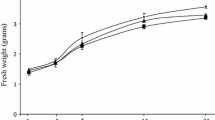Summary
Viability changes and hydrogen peroxide production in cultured Lycopersicon esculentum cv. Rio Grande (tomato) cells exposed to induced stress conditions have been investigated. Our data suggest that in order to obtain reliable and insightful data when the hypersensitive response is being evaluated as an early elicitor-induced viability change in suspension cultures, it is strongly advisable to use the assay based on the reduction of tetrazolium salts, since it provides an adequate indicator of changes in metabolic activity that could otherwise be overlooked.
Similar content being viewed by others
References
Delledonne, M.; Xia, Y.; Dixon, R. A.; Lamb, C. Nitric oxide functions as a signal in plant disease resistance. Nature 394:585–588; 1998.
Dorey, S.; Kopp, M.; Geoffroy, P.; Fritig, B.; Kauffmann, S. Hydrogen peroxide from the oxidative burst is neither necessary nor sufficient for hypersensitive cell death induction, phenylalanine ammonia lyase stimulation, salicylic acid accumulation, or scopoletin consumption in cultured tobacco cells treated with elicitin. Plant Physiol. 121:163–171; 1999.
Dubois, M.; Gilles, K. A.; Hamilton, J. K.; Rebers, P. A.; Smith F. Colorimetric method for determination of sugars and related substances. Anal. Chem. 28:350–356; 1956.
Frame, B.; Yun, K.-F.; Christie, B. R.; Pauls, K. P. In vitro selection for resistance to verticillium wilt in alfalfa (Medicago sativa L.) using a fungal culture filtrate. Physiol. Mol. Plant Pathol. 39:325–340; 1991.
Gamborg, O. L.; Miller, R. A.; Ojima, K. Nutrient requirements of suspension cultures of soybean root cells. Exp. Cell Res. 50:151–158; 1968.
Hammond-Kosack, K. E.; Jones, J. D. G. Resistance gene-dependent plant defense responses. Plant Cell 8:1773–1791; 1996.
Kodama, M.; Yoshida, T.; Otani, H.; Kohomoto, K.; Nishimura, S. Effect of AL-toxin on viability of cultured tomato cells determined by MTT-colorimetric assay. In: Patil, S., ed. Molecular strategies of pathogens and host plants. Berlin: Springer-Verlag; 1991:251.
Lamb, C.; Dixon, R. A. The oxidative burst in plant disease resistance. Annu. Rev. Plant Physiol. Plant Mol. Biol. 48:251–275; 1997.
Legendre, L.; Rueter, S.; Heinstein, P. F.; Low, P. S. Characterization of the oligogalacturonide-induced oxidative burst in cultured soybean (Glycine max) cells. Plant Physiol. 102:233–240; 1993.
Levine, A.; Tenhaken, R.; Dixon, R.; Lamb, C. H2O2 from the oxidative burst orchestrates the plant hypersensitive disease resistance response. Cell 79:583–593; 1994.
Mosmann, T. Rapid colorimetric assay for cellular growth and survival: application to proliferation and cytotoxicity assays. J. Immunol. Methods 65:55–63; 1983.
Murashige, T.; Skoog, F. A revised medium for rapid growth and bioassays with tobacco tissue cultures. Physiol. Plant. 15:473–497; 1962.
Sánchez, L. M.; Doke, N.; Kawakita, K. Elicitor-induced chemiluminescence in cell suspension cultures of tomato, sweet pepper and tobacco plants and its inhibition by suppressors from Phytophthora spp. Plant Sci. 88:141–148; 1993.
Scudiero, D. A.; Shoemaker, R. H.; Paull, K. D.; Monks, A.; Tierney, S.; Nofziger, T. H.; Currens, M. J.; Seniff, D.; Boyd, M. R. Evaluation of a soluble tetrazolium/formazan assay for cell growth and drug sensitivity in culture using human and other tumor cell lines. Cancer Res. 48:4827–4833; 1988.
Sutherland, M. W.; Learmonth, B. A. The tetrazolium dyes MTS and XTT provide new quantitative assays for superoxide and superoxide dismutase. Free Rad. Res. 27:283–289; 1997.
Vera-Estrella, R.; Blumwald, E.; Higgins, V. J. Effect of specific elicitors of Cladosporium fulvum on tomato suspension cells. Evidence for the involvement of active oxygen species. Plant Physiol. 99:1208–1215; 1992.
Zapata, J. M.; Salina, C.; Calderón, A. A.; Muñoz, R.; Barceló, A. R. Reduction of 2,3,5-triphenyltetrazolium chloride by the KNC-insensitive, salicylhydroxamic acid-sensitive alternative respiratory pathway of mitochondria from cultured grapevine cells. Plant Cell Rep. 10:579–582; 1991.
Author information
Authors and Affiliations
Corresponding author
Rights and permissions
About this article
Cite this article
Gracia-Medrano, R.M.E., Miranda-Ham, M.d.L. Analysis of elicitor-induced cell viability changes in Lycopersicon esculentum Mill. suspension culture by different methods. In Vitro Cell.Dev.Biol.-Plant 39, 236–239 (2003). https://doi.org/10.1079/IVP2002395
Received:
Accepted:
Issue Date:
DOI: https://doi.org/10.1079/IVP2002395




